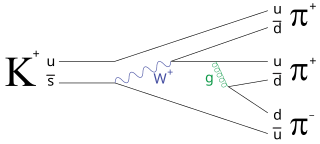Related Research Articles

The atomic number or proton number of a chemical element is the number of protons found in the nucleus of every atom of that element. The atomic number uniquely identifies a chemical element. It is identical to the charge number of the nucleus. In an uncharged atom, the atomic number is also equal to the number of electrons.

Deuterium is one of two stable isotopes of hydrogen. The nucleus of a deuterium atom, called a deuteron, contains one proton and one neutron, whereas the far more common protium has no neutrons in the nucleus. Deuterium has a natural abundance in Earth's oceans of about one atom in 6420 of hydrogen. Thus deuterium accounts for approximately 0.0156% of all the naturally occurring hydrogen in the oceans, while protium accounts for more than 99.98%. The abundance of deuterium changes slightly from one kind of natural water to another.

A hydrogen bond is a primarily electrostatic force of attraction between a hydrogen (H) atom which is covalently bound to a more electronegative atom or group, and another electronegative atom bearing a lone pair of electrons—the hydrogen bond acceptor (Ac). Such an interacting system is generally denoted Dn–H···Ac, where the solid line denotes a polar covalent bond, and the dotted or dashed line indicates the hydrogen bond. The most frequent donor and acceptor atoms are the second-row elements nitrogen (N), oxygen (O), and fluorine (F).

The muon is an elementary particle similar to the electron, with an electric charge of −1 e and a spin of 1/2, but with a much greater mass. It is classified as a lepton. As with other leptons, the muon is not known to have any sub-structure – that is, it is not thought to be composed of any simpler particles.

A proton is a stable subatomic particle, symbol
p
or
p+
, with a positive electric charge of +1e elementary charge. Its mass is slightly less than that of a neutron and 1836 times the mass of an electron. Protons and neutrons, each with masses of approximately one atomic mass unit, are jointly referred to as "nucleons".
An exotic atom is an otherwise normal atom in which one or more sub-atomic particles have been replaced by other particles of the same charge. For example, electrons may be replaced by other negatively charged particles such as muons or pions. Because these substitute particles are usually unstable, exotic atoms typically have very short lifetimes and no exotic atom observed so far can persist under normal conditions.

Pionium is a composite particle consisting of one
π+
and one
π−
meson. It can be created, for instance, by interaction of a proton beam accelerated by a particle accelerator and a target nucleus. Pionium has a short lifetime, predicted by chiral perturbation theory to be 2.89×10−15 s. It decays mainly into two
π0
mesons, and to a smaller extent into two photons.

The antiproton,
p
, is the antiparticle of the proton. Antiprotons are stable, but they are typically short-lived, since any collision with a proton will cause both particles to be annihilated in a burst of energy.
Ionizing radiation, including nuclear radiation, consists of subatomic particles or electromagnetic waves that have sufficient energy to ionize atoms or molecules by detaching electrons from them. The particles generally travel at a speed that is 99% of that of light, and the electromagnetic waves are on the high-energy portion of the electromagnetic spectrum.

In particle physics, a kaon, also called a K meson and denoted
K
, is any of a group of four mesons distinguished by a quantum number called strangeness. In the quark model they are understood to be bound states of a strange quark and an up or down antiquark.
Protonium, also known as antiprotonic hydrogen, is a type of exotic atom in which a proton and an antiproton orbit each other. Since protonium is a bound system of a particle and its corresponding antiparticle, it is an example of a type of exotic atom called an onium.

An air shower is an extensive cascade of ionized particles and electromagnetic radiation produced in the atmosphere when a primary cosmic ray enters the atmosphere. When a particle, which could be a proton, a nucleus, an electron, a photon, or (rarely) a positron, strikes an atom's nucleus in the air it produces many energetic hadrons. The unstable hadrons decay in the air speedily into other particles and electromagnetic radiation, which are part of the particle shower components. The secondary radiation rains down, including x-rays, muons, protons, antiprotons, alpha particles, pions, electrons, positrons, and neutrons.

In chemistry, a dihydrogen bond is a kind of hydrogen bond, an interaction between a metal hydride bond and an OH or NH group or other proton donor. With a van der Waals radius of 1.2 Å, hydrogen atoms do not usually approach other hydrogen atoms closer than 2.4 Å. Close approaches near 1.8 Å, are, however, characteristic of dihydrogen bonding.

Nuclear binding energy in experimental physics is the minimum energy that is required to disassemble the nucleus of an atom into its constituent protons and neutrons, known collectively as nucleons. The binding energy for stable nuclei is always a positive number, as the nucleus must gain energy for the nucleons to move apart from each other. Nucleons are attracted to each other by the strong nuclear force. In theoretical nuclear physics, the nuclear binding energy is considered a negative number. In this context it represents the energy of the nucleus relative to the energy of the constituent nucleons when they are infinitely far apart. Both the experimental and theoretical views are equivalent, with slightly different emphasis on what the binding energy means.

NGC 5364 is a grand design spiral galaxy located 54.5 million light years away in the constellation Virgo. It is inclined to the line of sight from the Earth at an angle of 47° along a position angle of 25°.

The helium hydride ion or hydridohelium(1+) ion or helonium is a cation (positively charged ion) with chemical formula HeH+. It consists of a helium atom bonded to a hydrogen atom, with one electron removed. It can also be viewed as protonated helium. It is the lightest heteronuclear ion, and is believed to be the first compound formed in the Universe after the Big Bang.
DAFNE or DAΦNE, is an electron-positron collider at the INFN Frascati National Laboratory in Frascati, Italy. It consists of 2 accelerator rings, both approximately 100 meters in length. Since 1999 it has been colliding electrons and positrons at a center of mass energy of 1.02 GeV to create phi mesons (φ). 85% of these decay into kaons (K), whose physics is the subject of most of the experiments at DAFNE.

Energetic neutral atom (ENA) imaging, often described as "seeing with atoms", is a technology used to create global images of otherwise invisible phenomena in the magnetospheres of planets and throughout the heliosphere.
The rms charge radius is a measure of the size of an atomic nucleus, particularly the proton distribution. It can be measured by the scattering of electrons by the nucleus. Relative changes in the mean squared nuclear charge distribution can be precisely measured with atomic spectroscopy.

In cosmology, decoupling refers to a period in the development of the universe when different types of particles fall out of thermal equilibrium with each other. This occurs as a result of the expansion of the universe, as their interaction rates decrease up to this critical point. The two verified instances of decoupling since the Big Bang which are most often discussed are photon decoupling and neutrino decoupling, as these led to the cosmic microwave background and cosmic neutrino background, respectively.
References
- ↑ Iwasaki, M.; Hayano, R.; Ito, T.; Nakamura, S.; Terada, T.; Gill, D.; Lee, L.; Olin, A.; Salomon, M.; Yen, S.; Bartlett, K.; Beer, G.; Mason, G.; Trayling, G.; Outa, H.; Taniguchi, T.; Yamashita, Y.; Seki, R. (1997). "Observation of Kaonic Hydrogen Kα X Rays". Physical Review Letters. 78 (16): 3067. Bibcode:1997PhRvL..78.3067I. doi:10.1103/PhysRevLett.78.3067.
- ↑ Beer, G.; Bragadireanu, A.; Cargnelli, M.; Curceanu-Petrascu, C.; Egger, J. -P.; Fuhrmann, H.; Guaraldo, C.; Iliescu, M.; Ishiwatari, T.; Itahashi, K.; Iwasaki, M.; Kienle, P.; Koike, T.; Lauss, B.; Lucherini, V.; Ludhova, L.; Marton, J.; Mulhauser, F.; Ponta, T.; Schaller, L.; Seki, R.; Sirghi, D.; Sirghi, F.; Zmeskal, J. (2005). "Measurement of the Kaonic Hydrogen X-Ray Spectrum" (PDF). Physical Review Letters. 94 (21): 212302. Bibcode:2005PhRvL..94u2302B. doi:10.1103/PhysRevLett.94.212302. PMID 16090312.
- 1 2 Bazzi, M.; Beer, G.; Bombelli, L.; Bragadireanu, A. M.; Cargnelli, M.; Corradi, G.; Curceanu (Petrascu), C.; Dʼuffizi, A.; Fiorini, C.; Frizzi, T.; Ghio, F.; Girolami, B.; Guaraldo, C.; Hayano, R. S.; Iliescu, M.; Ishiwatari, T.; Iwasaki, M.; Kienle, P.; Levi Sandri, P.; Longoni, A.; Lucherini, V.; Marton, J.; Okada, S.; Pietreanu, D.; Ponta, T.; Rizzo, A.; Romero Vidal, A.; Scordo, A.; Shi, H.; Sirghi, D. L. (2011). "A new measurement of kaonic hydrogen X-rays". Physics Letters B. 704 (3): 113–117. arXiv: 1105.3090 . Bibcode:2011PhLB..704..113S. doi:10.1016/j.physletb.2011.09.011. S2CID 118473154.
- ↑ Yiguang Yan, Kaonic hydrogen atom and kaon-proton scattering length, arXiv : 0905.4818